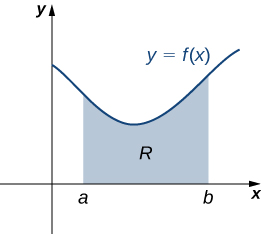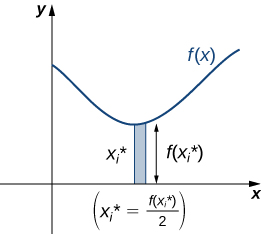Center of Mass of Thin Plates
We’ve examined point masses on a line and in a plane. Now, we look at systems where mass is distributed continuously across a thin sheet, called a lamina. We assume the lamina’s density is constant.
Laminas are often two-dimensional regions in a plane, with the geometric center called its centroid. The center of mass of a lamina depends only on the shape, not the density. For a rectangular lamina, the center of mass is where the diagonals intersect, which follows the symmetry principle.
the symmetry principle
If a region [latex]R[/latex] is symmetric about a line [latex]l[/latex], then the centroid of [latex]R[/latex] lies on [latex]l[/latex].
Let’s examine general laminas. Suppose we have a lamina bounded above by the graph of a continuous function [latex]f(x),[/latex] below by the [latex]x[/latex]-axis, and on the left and right by the lines [latex]x=a[/latex] and [latex]x=b,[/latex].

To find the center of mass, we need the total mass of the lamina. We divide the lamina into thin vertical strips, approximating each strip’s mass using the density [latex]ρ[/latex]. The mass of the strip is given by [latex]\rho f({x}_{i}^{*})\text{Δ}x.[/latex]

To get the approximate mass of the lamina, we add the masses of all the rectangles to get
This is a Riemann sum. Taking the limit as [latex]n\to \infty[/latex] gives the exact mass of the lamina:
Next, we calculate the moment of the lamina with respect to the x-axis. For each rectangle, the center of mass is at [latex]x_{i}^{*}[/latex]. The moment with respect to the [latex]x[/latex]-axis is given by:
Similarly, the moment with respect to the [latex]y[/latex]-axis is:
The coordinates of the center of mass are:
[latex]\overline{x}=\frac{{M}_{y}}{m} \text{ and }\overline{y}=\frac{{M}_{x}}{m}[/latex]
If we look closely at the expressions for [latex]{M}_{x},{M}_{y},\text{ and }m,[/latex] we notice that the constant [latex]\rho[/latex] cancels out when [latex]\overline{x}[/latex] and [latex]\overline{y}[/latex] are calculated.
We summarize these findings in the following theorem.
center of mass of a thin plate in the [latex]xy[/latex]-plane
Let [latex]R[/latex] denote a region bounded above by the graph of a continuous function [latex]f(x),[/latex] below by the [latex]x[/latex]-axis, and on the left and right by the lines [latex]x=a[/latex] and [latex]x=b,[/latex] respectively. Let [latex]\rho[/latex] denote the density of the associated lamina. Then we can make the following statements:
- The mass of the lamina is
[latex]m=\rho {\displaystyle\int }_{a}^{b}f(x)dx.[/latex]
- The moments [latex]{M}_{x}[/latex] and [latex]{M}_{y}[/latex] of the lamina with respect to the [latex]x[/latex]– and [latex]y[/latex]-axes, respectively, are
[latex]{M}_{x}=\rho {\displaystyle\int }_{a}^{b}\frac{{\left[f(x)\right]}^{2}}{2}dx\text{ and }{M}_{y}=\rho {\displaystyle\int }_{a}^{b}xf(x)dx.[/latex]
- The coordinates of the center of mass [latex](\overline{x},\overline{y})[/latex] are
[latex]\overline{x}=\frac{{M}_{y}}{m}\text{ and }\overline{y}=\frac{{M}_{x}}{m}.[/latex]
In the next example, we use this theorem to find the center of mass of a lamina.
Let R be the region bounded above by the graph of the function [latex]f(x)=\sqrt{x}[/latex] and below by the [latex]x[/latex]-axis over the interval [latex]\left[0,4\right].[/latex] Find the centroid of the region.
